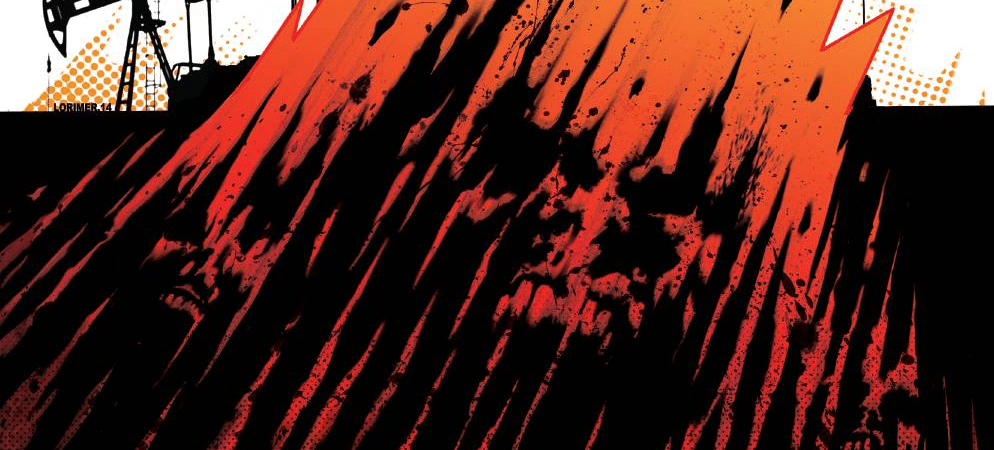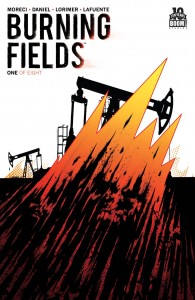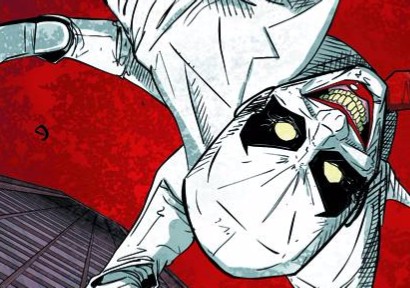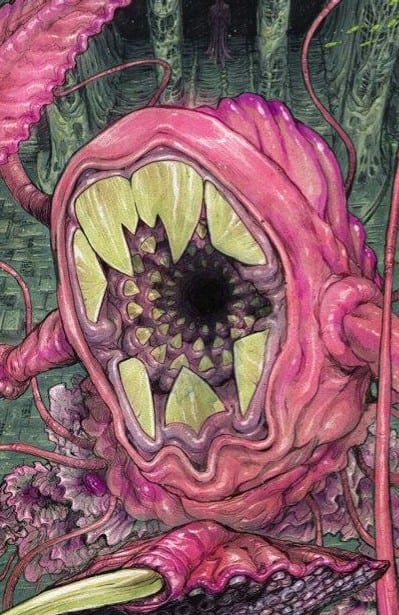
Comic Review: BURNING FIELDS #1
BURNING FIELDS #1
Writer: Michael Moreci & Tim Daniel
Artist: Colin Lorimer
Colorist: Joana Lafuente
Publisher: BOOM! Studios
Price: $4
We’ve talked about the work of artist Colin Lorimer more than once in the past here at Destroy The Brain. He was the artist on sci-fi thriller Blackout as well as a contributing artist on Hellraiser: Bestiary and the consensus is that he’s one of the best comic book artists working in horror right now so when it was announced that he would be doing a brand new horror comic with Hoax Hunters creator Michael Moreci, I was keen to see the results, as their work together on the under-appreciated werewolf horror book Curse deserved more attention than it got (certainly, I’m to blame for ignoring it completely). Now that Burning Fields has rather quickly arrived in my hot little hands, let’s look at how Lorimer’s work with Moreci has progressed.
Moreci seems to have learned his lesson from Curse (perhaps thanks to his co-writer Tim Daniel), which is that writing a horror story that relies on a well-known horror trope (werewolves) is a double-edged sword; on the one hand, it will certainly bring in the diehard fans of that particular tradition but it also risks a certain amount of disdain from the horror dilettantes (of which I am admittedly one) who pursue savvier fare. Burning Fields immediately eschews an obvious “monster” on which to pin the mysterious murder that the first issue orbits around; we know the hand that commits the gruesome chore is, by appearance, a human one. Is it a crime whose motivation lies beyond the natural world? It’s a pretty safe assumption, given the seemingly inhuman nature of the act, revealed on the very last page, natch. But what leads up to that is absolutely human drama of a pleasingly complex variety. Our protagonist, an ex-Marine with some very unsavory occupational ties in her history, is called upon to investigate the aforementioned grisly homicide (one depicted teasingly in the opening pages) and we discover the first (perhaps obvious) twist of Burning Fields; the tale takes place in Kirkuk, Iraq. Not exactly comfortable territory for the world of horror comics; delving into the post-Operation Iraqi Freedom world of Iraq is controversial no matter the approach, and invoking the unarguably sketchy involvement of security contractors is doing the story no favors.
Thankfully, Moreci & Daniel don’t try to apologize to their readers for being so bold and instead aggressively depicts said contractors as awkward interlopers, immediately establishing the complicated relationship between Iraqi civilians resentful of their presence, the Iraqi law enforcement agents tasked with refereeing these conflicts and the writers’ fictional PMC, “Verge.” One of the aforementioned Iraqi police does provide a foil to cynical, reluctant main character Dana, framed by the somewhat maudlin drama his PMC-hating son stirs up (or rather, fails to). The immediate juxtaposition of the Iraqi, Detective Fasad, and ex-contractor Dana, is pleasingly unusual. Fasad and Dana are both sketched as character on moral fences; Dana hates Verge but feels an obligation to step in and try to heal the wounds she feels responsible for while Fasad has to live with the perpetual compromise of what the American interests in Iraq are (oil) and what the Iraqis themselves want (to be left alone).
There is no absolute with either of them, and while the PMC isn’t given any kind of leniency (and the documented real life cases bear this out), the way the confrontation between the civilians and Verge soldiers is posed doesn’t take sides; throwing rocks at a tank is a bad idea, a difficult bit of wisdom Fasad tries to impart to his son in a scene that doesn’t honestly feel too far from the truth. Moreci is smart enough to keep a lot of the Iraqi/PMC exposition on Fasad’s side and makes it pretty clear that the problem isn’t necessarily the PMC itself but its sketchy, disrespectful behavior that’s driven by the most unsavory kind of character, de facto villain Commander Decker. How do you know Decker is the villain? Because he sneakily defuses the potentially unpleasant confrontation by dressing down his own men in front of the Iraqis, making sure the people present think that he’s there to appease their frustrations while, in fact, acting only to smooth the process of getting his way. He’s the kind of bad guy I love; he knows how to manipulate and will gladly act appalled if it means someone else will roll over for him. Is he responsible for the core horrors that Burning Fields eventually unfolds before its readers? Highly, highly unlikely, and frankly I’d be disappointed in Moreci and Daniel if that was the case, but he’s a character whose subtlety and nuance shows that the writer isn’t interested in archetypes or tropes; Burning Fields invokes the real.
Colin Lorimer is known for his sturdy yet flexible style, a combination of photo-realism and lush textures that rarely becomes stiff or rote convention. The opening pages, in their drastic zoom focus, successfully convey claustrophobic terror in unflinchingly graphic violence, narrowing on a tool of torture and following it from threat to execution. His work is strongly cinematic and this is absolutely the optimal choice for Burning Fields; the drama that follows the opening carnage is pregnant with tension, thanks to subtle but effective POVs and layouts that focus the narrative to a sharp edge. Page five launches with a silhouetted page-wide establishing shot, followed by two panels of the participants of a conversation, compressed side-by-side, a one-two beat that explodes into a wide-lens close-up, with a return to the protagonists response closing off the volley, and all of these panels are lined up down the center of the page beneath the establishing shot. Just explaining how it is laid out doesn’t successfully get across how thoughtful and well-executed this page is, proving that Lorimer and Moreci know that exposition needs to be treated like action, with controlled expressiveness. There’s so much strong, dynamic work in the layouts and POVs, some of it bordering on experimental; the ambush in Dana’s apartment is severed crookedly by a chain of small panels that convey Dana’s punishing self defense moves, Lorimer’s tightly controlled art imparting each moment of action clearly.
But Lorimer is one of three fantastic artists churning behind the scenes of Burning Fields; Colorist Joana Lafuente is absolutely 100% in sync with Lorimer, gracing each page with the perfect level of grim hues, saturating but effectively adding splashes of contrast and elevating utilitarian backgrounds to significant elements of the book’s overall tone. Using gradients in the opening sequence is brilliant, avoiding entirely the peril of monotone tedium and additionally lending the crimson splatters a bolder presence. She stunningly renders a nighttime cityscape of Kirkuk in moody dark tones without hiding Colin’s massive level of detail and that alone is impressive. Then to equally successfully switch to a blistering-looking daytime scene, the dusty colors compounding the simmering emotions imparted by densely packed panels full of Iraqis. Alongside Lafuente, letterer Jim Campbell ruthlessly jams unsettling sound effects with just the right timing, keys clatter, wrists crack, shotguns roar, etc. Where there’s an opportunity to heighten the suspense and action with tense, effectively-placed lettering, Campbell is right on the mark.
What we have here, with the first issue of Burning Fields, is a massive debut worthy of attention. Writers Tim Daniel and Michael Moreci have absolutely knocked it out of the park, seamlessly blending political drama with murky action and looming dread. If this were a movie or TV show, it would be as critically acclaimed (and likely as popular) as True Detective or Homeland. In fact, Burning Fields feels like what those shows were grasping for but failed at. Burning Fields proves that comics are a medium that can do better.




